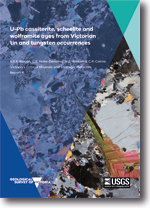VCMSM Report 6 - U-Pb cassiterite, scheelite and wolframite ages from Victorian tin and tungsten occurrences.
 |
| |||||
Product description:Executive Summary:As part of the Developing Victoria's Critical Minerals Initiative, new pre-competitive geoscience has determined the age of a select number of tin (Sn) and tungsten (W) occurrences in east-central and northeast Victoria through the direct dating of ore minerals cassiterite, scheelite, and wolframite. These ages are important inputs for mineral systems analyses and prospectivity studies as they provide insights into the temporal and spatial distribution of mineralisation events. The results indicate that there are two tin and tungsten mineralising events within the Omeo Zone of northeast Victoria, which fall within periods of Silurian and Devonian magmatism as determined by uranium (U)-lead (Pb) zircon geochronology. The first event occurred during a period of magmatism between circa (ca.) 435–418 Ma, accompanied by high-temperature (T) low-pressure (P) metamorphism and associated volcanism and sediment deposition across the Omeo, Deddick and Kuark zones. This event produced tin-bearing lithium-caesium-tantalum pegmatites and tungsten mineralisation in the Omeo Zone. The second event occurred synchronous with magmatism between ca. 417–390 Ma that is widely expressed in all Victorian structural zones, with the exception of the Melbourne Zone. This event produced tungsten-molybdenum-bismuth mineralisation, along with gold-silver-copper and copper-molybdenum-silver deposits in the Omeo Zone. In the New South Wales portion of the Wagga-Omeo Metamorphic Belt, intrusion-related tin, intrusion-related gold and porphyry-epithermal gold deposits were also formed during this magmatic period (Gilmore, 2019). A third event occurred during a period of late Devonian magmatism ca. 385-360 Ma that is limited to central Victora, encompassing the eastern Stawell Zone and the Bendigo, Melbourne and Tabberabbera Zones. It resulted in tungsten ± molybdenum mineralisation in the Melbourne Zone. To the south, many of Tasmania’s tin ± tungsten deposits formed during the same period. U-Pb geochronology of tin and tungsten ore minerals is an emerging technique and further work is recommended to increase confidence in the accuracy and precision of existing dates and improve the understanding of relevant mineral systems in Victoria and across southeast Australia. Bibliographic Reference: Waugh, S.A.F., Holm-Denoma, C.S., Wintzer, N.E. & Cairns, C.P., 2024. U-Pb cassiterite, scheelite and wolframite ages from Victorian tin and tungsten occurrences. Victoria's Critical Minerals and Strategic Materials Report 6. Geological Survey of Victoria, Department of Energy, Environment and Climate Action, Melbourne, 42 pp. Download: The downloadable version of this report is supplied as PDF (12 MB) & Attachment A2 (ZIP/ODS/XLSX 50KB). | ||||||

